
Maluku is a region of Indonesia that is well below the radar of most people, even Indonesians. Maluku or the Moluccas as the early Dutch colonialists called it, was once the centre of the global spice trade. Two of the key spices of that time botanically originated in the area. Cloves originated around Ternate and Nutmeg, which also yields Mace, originated in the islands of Banda. The once mighty VOC or Dutch East India Company ruthlessly controlled the spice trade from their HQ in the spice islands, that we know today as Indonesia. Since the collapse of the Spice trade several hundred years ago, the Maluku islands have simple been forgotten in time. In modern day Indonesia, Maluku is divided into various provinces and regencies and geographically speaking there are several island groups that make up Maluku. The Kei Islands (the Dutch Era spelling, which persists, is Kai Islands) are just one of these groups.
 Map of Maluku (the Moluccas) showing North Maluku Province in Yellow, and Maluku Province including the Kei (Kai) Islands in Pink from Wikipedia
Map of Maluku (the Moluccas) showing North Maluku Province in Yellow, and Maluku Province including the Kei (Kai) Islands in Pink from Wikipedia
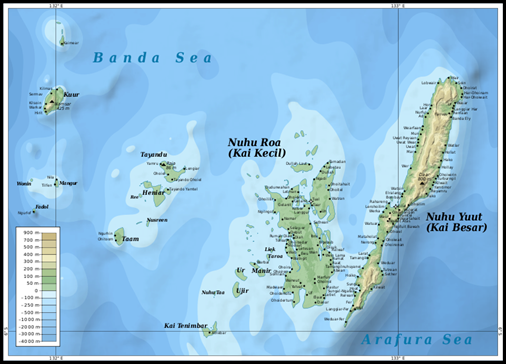 Topographic map of the Kei (Kai) Islands from Wikipedia
Topographic map of the Kei (Kai) Islands from Wikipedia
As with many places in Indonesia, place names can get confusing. The correct spelling today for these islands is the Kei Islands, pronounced “key” or in Bahasa Indonesian Kepulauan Kei. The Dutch spelling as noted above was Kai, but still pronounced “key”. As with many of the Dutch names in Indonesia they persist in maps, charts and other similar references. In the local language the islands are known as Nuhu Evav (or Evav Islands in English). Even the place names within the Kei Islands can be confusing. The location of my visit was Dullah Village. The Dutch spelt this village as Doela, which still appears in places such as Google Earth. Other maps spell it as Dula, even if the locals themselves always spell it as Dullah. To complicate it even more, whilst Dullah Village is on one of the main islands (Kei Kecil or Nuhu Roa) a short distance away there is a completely separate island also called Dullah.
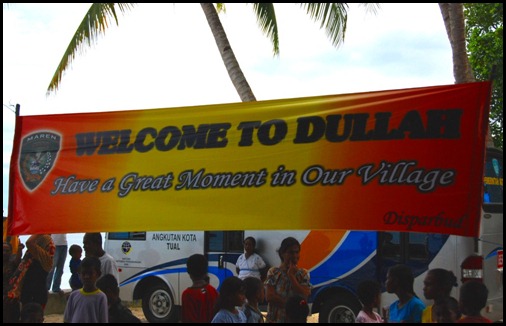 the people of Dullah spared no expense to welcome us with their sign, written in what's become known as Engrish – that is English with grammatical or spelling mistakes commonly found in East Asia. “Have a Great Moment in our Village!”
the people of Dullah spared no expense to welcome us with their sign, written in what's become known as Engrish – that is English with grammatical or spelling mistakes commonly found in East Asia. “Have a Great Moment in our Village!”
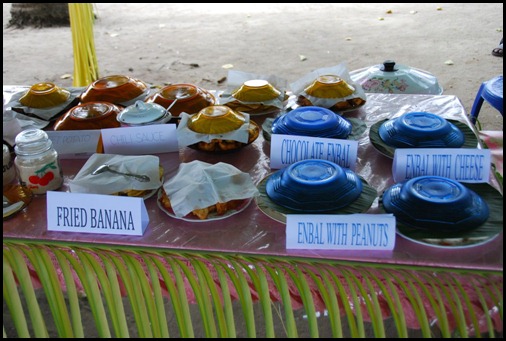 Typical Indonesian welcomes involve lots of food, and Dullah Village was no different. Many of the dishes were based on the staple Enbal aka Cassava aka Tapioca aka Manioc depending on where you are from
Typical Indonesian welcomes involve lots of food, and Dullah Village was no different. Many of the dishes were based on the staple Enbal aka Cassava aka Tapioca aka Manioc depending on where you are from
Travellers visiting the Kei Islands are not that common. The islands are famous for their beaches, at one stage Lonely Planet had named one of Kei’s beaches in the top 10 in the world. Geographically speaking the islands are special because they fall between the former great continents of Sahul (Australia and New Guinea, the Australian Continental Shelf) and Sunda (Java, Malaysia etc., the Asian Continental Shelf) having never been a part of either, sitting by themselves in the deep water zone between the two (there is a map showing this in my previous post >>here<<). Biologically speaking this deep water zone is significant as it form the boundary between the Asiatic Flora and Fauna and the Australian flora and fauna. This area was made famous by the work done by Alfred Russell Wallace and his Wallace Line theory. Biologically the area is refereed to as Wallacea. But the culture of these islands is fairly interesting too. Island legend refers to the arrival of the Royal Family from Bali arriving there, the Royal Family representing the Hindu Majapahit Kingdom that spread from India, with its local power base in Java. The Majapahit Kingdom was a vast archipelagic empire based on the island of Java from 1293 to around 1500 and exercised control over most of Maluku including the Kei Islands. The genetic features of the Kei Islanders and aspects of their dress and dance reflects the Hindu-Majapahit influence.
 Kei Island dress and dance reflects influence of the Hindu-Majapahit Empire
Kei Island dress and dance reflects influence of the Hindu-Majapahit Empire
 Kei Island dress and dance reflects influence of the Hindu-Majapahit Empire
Kei Island dress and dance reflects influence of the Hindu-Majapahit Empire
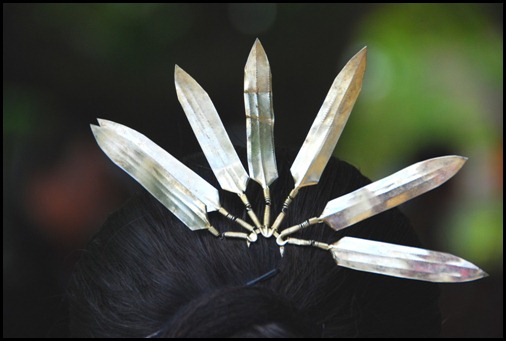 Kei Island dress and dance reflects influence of the Hindu-Majapahit Empire
Kei Island dress and dance reflects influence of the Hindu-Majapahit Empire
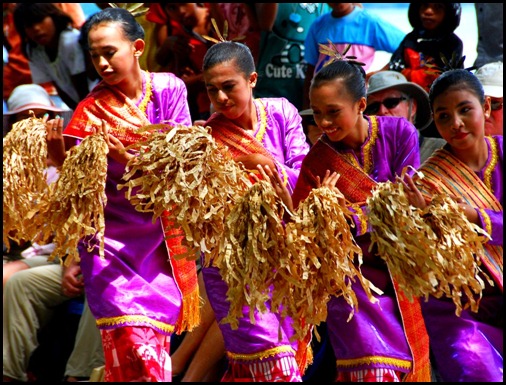 Kei Island dress and dance reflects influence of the Hindu-Majapahit Empire
Kei Island dress and dance reflects influence of the Hindu-Majapahit Empire
As with much of Indonesia, and indeed other areas like Malaysia and Singapore, the seafaring peoples of Sulawesi, the Buginese and Makassans have transmigrated heavily into surrounding coastal regions and the Kei Islands are no exception. The Hindu religion of the Majapahit era is today practised only in small pockets, and the Christian views brought by the Dutch colonialists is challenged by the Islamic beliefs of the Trans Migrating Makassans. The populations of the Kei islands are now almost equally split between Christian and Muslim. These Islamic influences are also evident in the culture of the Kei Island’s today, and whilst some dress and dance reflects the earlier Hindu influence, the music of today is heavily influenced by Islam.

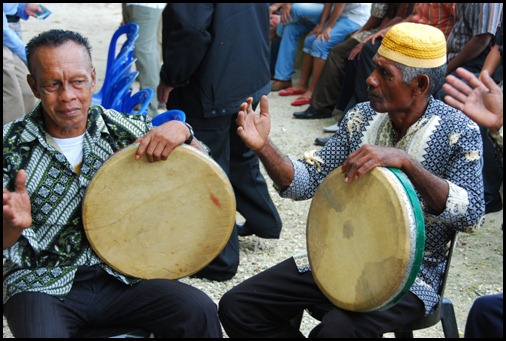 Kei Island music reflects many influences, including that of the Islamic migrations from Sulawesi. Here local Muslim men play the local drums known as “Tiva”
Kei Island music reflects many influences, including that of the Islamic migrations from Sulawesi. Here local Muslim men play the local drums known as “Tiva”

This particular visit to the Kei Islands was technically an unplanned visit. The group I was with were scheduled to visit the nearby Tanimbar Islands in Maluku however due to some timing challenges we had to change the program at the last minute and the Kei Islands just happened to fit the new time schedule better.
Travel Writer, Vincent Ross, accompanied us on this visit to the Kei Islands and he made this short video of our welcome from the local people
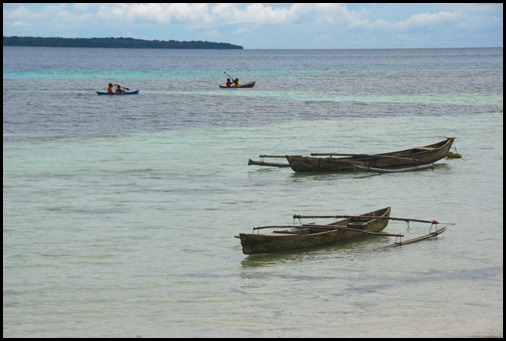 Arriving from the sea, we were greeted by numerous canoes
Arriving from the sea, we were greeted by numerous canoes
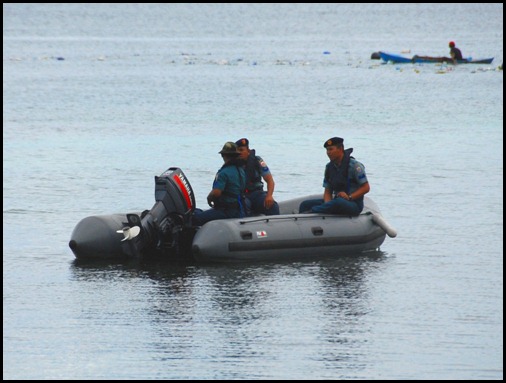 Arriving from the sea, we were also greeted by the local POLAIR in a flash new inflatable boat
Arriving from the sea, we were also greeted by the local POLAIR in a flash new inflatable boat
 This local seaweed is used to make a refreshing drink….apparently……
This local seaweed is used to make a refreshing drink….apparently……
So as I noted earlier, travellers rarely make it to the Kei Islands. If you do make it there, whether its for the geographic, biological or cultural uniqueness, you are guaranteed to stand out from the locals……..
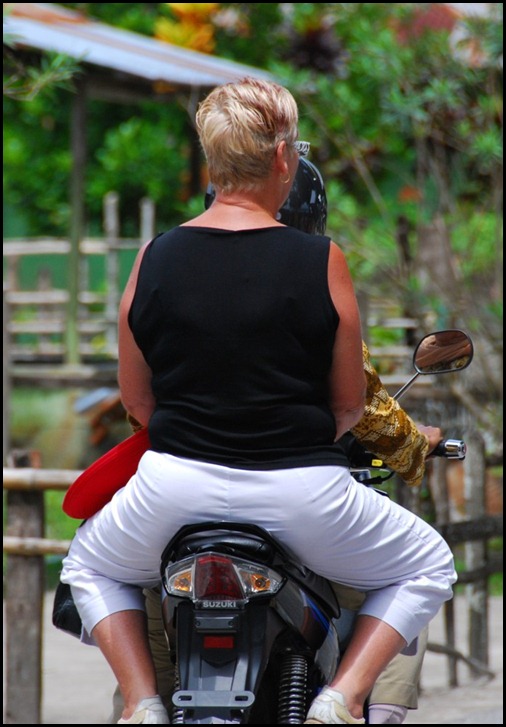
![untitled-truecolo r-08[2] untitled-truecolo r-08[2]](http://lh5.ggpht.com/-QAkCdTdI2sg/TfgbplbaklI/AAAAAAAABTo/piQHua7-ByI/untitled-truecolo%252520r-08%25255B2%25255D%25255B2%25255D.jpg?imgmax=800)
So you want to go to the Kei Islands?
- Wings Air, Express Air and Trigana Air, at the time of writing are all currently flying to the Kei Islands. The current airstrip is a military airfield, with a commercial airport due to open in 2012. Flights depart Jakarta and other major Indonesian Hubs, via other points in Maluku.
- Once on the island public minivans and motorcycles, or rental vans and motorcycles are abundant and getting around is easy enough as for most of Indonesia.
- Most Indonesian travel agents specialising in the remote islands can make advance arrangements for you if you desire

No comments:
Post a Comment